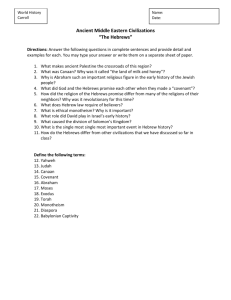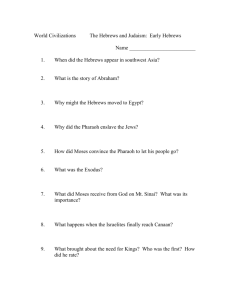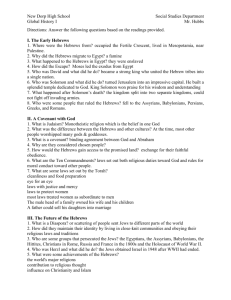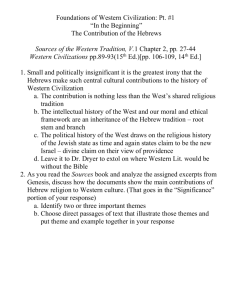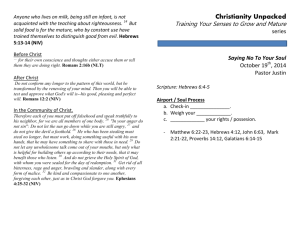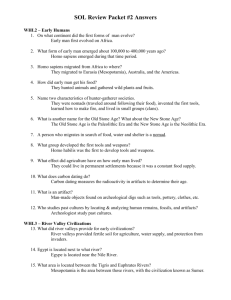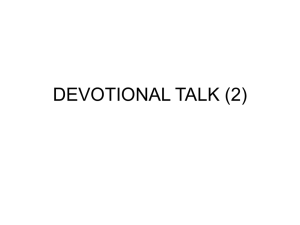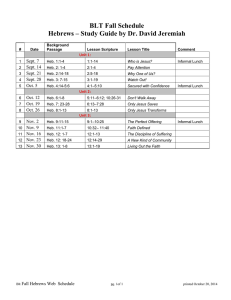Westminster Theological Journal 61 (1999)
advertisement
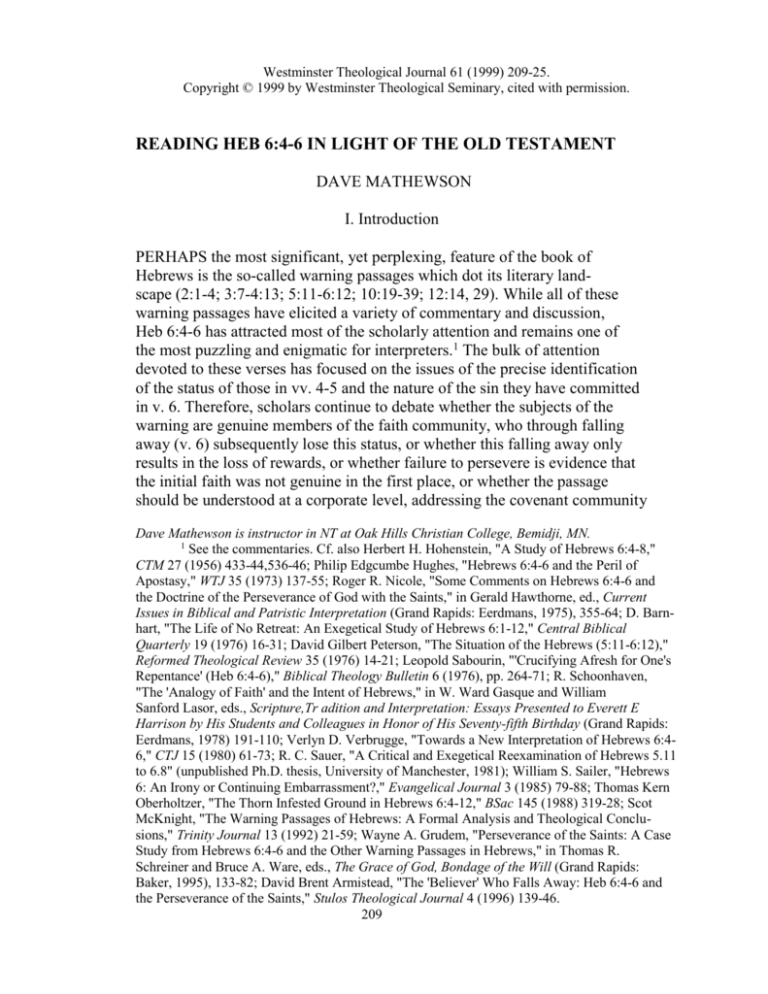
Westminster Theological Journal 61 (1999) 209-25.
Copyright © 1999 by Westminster Theological Seminary, cited with permission.
READING HEB 6:4-6 IN LIGHT OF THE OLD TESTAMENT
DAVE MATHEWSON
I. Introduction
PERHAPS the most significant, yet perplexing, feature of the book of
Hebrews is the so-called warning passages which dot its literary landscape (2:1-4; 3:7-4:13; 5:11-6:12; 10:19-39; 12:14, 29). While all of these
warning passages have elicited a variety of commentary and discussion,
Heb 6:4-6 has attracted most of the scholarly attention and remains one of
the most puzzling and enigmatic for interpreters.1 The bulk of attention
devoted to these verses has focused on the issues of the precise identification
of the status of those in vv. 4-5 and the nature of the sin they have committed
in v. 6. Therefore, scholars continue to debate whether the subjects of the
warning are genuine members of the faith community, who through falling
away (v. 6) subsequently lose this status, or whether this falling away only
results in the loss of rewards, or whether failure to persevere is evidence that
the initial faith was not genuine in the first place, or whether the passage
should be understood at a corporate level, addressing the covenant community
Dave Mathewson is instructor in NT at Oak Hills Christian College, Bemidji, MN.
1
See the commentaries. Cf. also Herbert H. Hohenstein, "A Study of Hebrews 6:4-8,"
CTM 27 (1956) 433-44,536-46; Philip Edgcumbe Hughes, "Hebrews 6:4-6 and the Peril of
Apostasy," WTJ 35 (1973) 137-55; Roger R. Nicole, "Some Comments on Hebrews 6:4-6 and
the Doctrine of the Perseverance of God with the Saints," in Gerald Hawthorne, ed., Current
Issues in Biblical and Patristic Interpretation (Grand Rapids: Eerdmans, 1975), 355-64; D. Barnhart, "The Life of No Retreat: An Exegetical Study of Hebrews 6:1-12," Central Biblical
Quarterly 19 (1976) 16-31; David Gilbert Peterson, "The Situation of the Hebrews (5:11-6:12),"
Reformed Theological Review 35 (1976) 14-21; Leopold Sabourin, "'Crucifying Afresh for One's
Repentance' (Heb 6:4-6)," Biblical Theology Bulletin 6 (1976), pp. 264-71; R. Schoonhaven,
"The 'Analogy of Faith' and the Intent of Hebrews," in W. Ward Gasque and William
Sanford Lasor, eds., Scripture,Tr adition and Interpretation: Essays Presented to Everett E
Harrison by His Students and Colleagues in Honor of His Seventy-fifth Birthday (Grand Rapids:
Eerdmans, 1978) 191-110; Verlyn D. Verbrugge, "Towards a New Interpretation of Hebrews 6:46," CTJ 15 (1980) 61-73; R. C. Sauer, "A Critical and Exegetical Reexamination of Hebrews 5.11
to 6.8" (unpublished Ph.D. thesis, University of Manchester, 1981); William S. Sailer, "Hebrews
6: An Irony or Continuing Embarrassment?," Evangelical Journal 3 (1985) 79-88; Thomas Kern
Oberholtzer, "The Thorn Infested Ground in Hebrews 6:4-12," BSac 145 (1988) 319-28; Scot
McKnight, "The Warning Passages of Hebrews: A Formal Analysis and Theological Conclusions," Trinity Journal 13 (1992) 21-59; Wayne A. Grudem, "Perseverance of the Saints: A Case
Study from Hebrews 6:4-6 and the Other Warning Passages in Hebrews," in Thomas R.
Schreiner and Bruce A. Ware, eds., The Grace of God, Bondage of the Will (Grand Rapids:
Baker, 1995), 133-82; David Brent Armistead, "The 'Believer' Who Falls Away: Heb 6:4-6 and
the Perseverance of the Saints," Stulos Theological Journal 4 (1996) 139-46.
209
210
WESTMINSTER THEOLOGICAL JOURNAL
rather than individuals.2 One of the most insightful studies to appear in
recent years is the article by Scot McKnight, who surveys and interacts
with a variety of approaches to the interpretation of this passage.3 McKnight
provides a fresh, detailed formal analysis of 6:4-6 and the other warning
passages in Hebrews, suggesting that the warning passages, especially 6:4-6,
should be read synthetically in relationship to one another rather than
individually. Based on his analysis McKnight concludes that the warnings
address the sin of apostasy, and that although believers experience the
reality of salvation in the present, a failure to persevere to the end can result
in the cessation of that reality.
In this article I do not wish to solve all the problems engendered by
Heb 6:4-6. Rather, the purpose of the present article is to suggest a further
element that has not yet sufficiently been considered in interpreting this
section of Hebrews in hopes of providing fresh exegetical insight into understanding this puzzling passage. More specifically, I wish to propose reading
Heb 6:4-6 in light of an OT background. In fact, I would contend that
much misunderstanding of this section of Hebrews stems from a failure to
appreciate its OT matrix.
Hermeneutically, one of the most significant observations for interpreting
Heb 6:4-6 has been articulated by McKnight. As mentioned above, the
warning passages in Hebrews should not be read in strict isolation from
one another, as is frequently the case, but should be read synthetically.4
McKnight helpfully suggests that formally each warning is comprised of
four basic components that provide a basis for comparison with the other
warnings: audience, sin, exhortation, and consequences.5 Based on this observation, a key feature comes into play which points to a neglected element in
interpreting 6:4-6. Scholars have frequently noticed that one of the common features of the warning passages in Hebrews is that each exhibits an
OT example to illustrate the warning in question. The following comparison
displays the warnings found in Hebrews along with the corresponding OT
examples contained in each warning.
Warning
OT Example
2:1-4
2:2 disobedience to the Mosaic law
3:7-4:13
3:16-19; 4:2 the failure at Kadesh-barnea
10:19-39
10:28 disobedience to the Mosaic law
12:14-29
12:16-17 the failure of Esau;
12:25-26 -failure to listen to
God's voice at Sinai.
2
Cf. esp. McKnight, "Warning Passages;" Nicole, "Hebrews 6:4-6," Current Issues;
Oberholtzer, "Hebrews 6:4-12;" Verbrugge, "New Interpretation," respectively.
3
"Warning Passages."
4
Ibid., 22-23.
5
Ibid., 27-29. McKnight suggests the significance of this observation: "I will propose that
a synthesis of each component as revealed in each warning passage provides clarity on the
meaning of a given component in a single passage" (26).
HEB 6:4-6 IN LIGHT OF THE OLD TESTAMENT
211
Consequently, in addition to McKnight's enumeration of four components
of audience, sin, exhortation and consequences which comprise the warning passages, I would suggest a fifth component: OT example.
The only exception to this pattern, however, appears to be 6:4-6. Thus, Paul
Ellingworth observes that "This passage [5:11-6:12] is almost as remarkable for what it does not say as for what it does. Like 3:7-4:13, it contains
only passing mention of Christ (6:1, 6), but unlike the earlier passage, it is
not based on any Old Testament passage either: The writer is appealing to his
readers in his own words."6 Philip Edgcumbe Hughes admits that “the calamitous
history of the Israelites of old is repeatedly set before the readers as a
warning against the imitation of their evil example (2:lf; 3:12ff.; 4:1f., 11;
10:28ff.; 12:25ff.) . . .,"7 but Hughes does not include a reference to the
warning in 5:11-6:12. In his detailed and thorough analysis of the warnings
in Hebrews, McKnight makes no mention of any OT illustration in 6:4-6.
The recent discussion of the OT background to Hebrews by R. T. France
proposes that an exposition of Psalm 110 more broadly underlies Heb 5:57:28, although this does not help us arrive at an answer to the question of
whether an OT illustration illuminates 6:4-6 in particular.8 More recently,
George H. Guthrie has discussed the use of the OT in Hebrews. Yet despite
the extensive nature of Guthrie's list of OT parallels for Hebrews, no OT
parallels are given for 6:4-6.9
However, I would propose that, like the other warnings in Hebrews, a
specific OT example can also be detected in the warning of 6:4-6, and that
this constitutes one of the keys to interpreting this warning. More specifically,
behind 6:4-6 lies a reference to the wildernes generation and the Kadeshbarnea incident (cf. Numbers 13-14; Psalm 95) which featured prominently
in the warning in 3:7-4:13. In a footnote in his insightful commentary on
Hebrews, F. F. Bruce briefly entertained the possibility that in 6:4-6 "the
wilderness narrative [the failure of the Israelites to enter Canaan] is still in
our author's mind," although he fails to offer any substantiation for his brief
6
The Epistle to the Hebrews (Epworth Commentaries; London: Epworth Press, 1991),
42, italics mine. See also the comments of Erich GraBer, who concludes that the writer describes
the state of his readers "in eigener Terminologie" (An Die Hebraer [Heb7: 1-6], EKK, XVII/I
[Benziger/Neukirchener, 1990] 347).
7
A Commentary on the Epistle to the Hebrews (Grand Rapids: Eerdmans, 1977), 216.
8
"The Writer of Hebrews as a Biblical Expositor," TynBul 47.2 (1996) 245-76. France's
proposal is a modification of the suggestion of Richard N. Longenecker that Hebrews contains
five extended expositions of Old Testament texts (Biblical Exegesis in the Apostolic Period
[Grand Rapids: Eerdrnans, 1975], 178-85). France postulates seven extended expositions: Ps 8:46 in Heb 2:5-18; Ps 95:7-11 in Heb 3:7-4:13; Ps 110 in Heb 5:5-7:28;Jer 31:31-34 in Heb 8:110:18; Hab 2:3c-4 (LXX) in Heb 10:32-12:3; Prov 3:11-12 in Heb 12:4-13; the Mount Sinai
motif in Heb 12:18-29.
9
"Old Testament in Hebrews," in Ralph P; Martin and Peter H. Davids, eds., Dictionary
oj the Later New Testament and Its Developments (Downers Grove/Leicester: Inter Varsity Press,
1997), 841-50. See the helpful chart of Old Testament references in Hebrews (846-49).
212
WESTMINSTER THEOLOGICAL JOURNAL
assertion or tease out the possible hermeneutical implications.10 This present
article will attempt to give further substantiation and shape to this suggestion
and briefly explore some of the implications of reading this warning in light
of this proposed OT background.
II. The OT Background for 3:7-4:13
The exhortation articulated in 6:4-6 follows on the heels of a previous,
lengthy warning embedded in chaps. 3-4; therefore this section requires
brief analysis in order to provide the context for the ensuing discussion. In
the second warning given in Heb 3:7-4:13 the Kadesh-barnea incident
from Numbers 13-14 is recalled via Psalm 95 (94):7b-11, which the writer of
Hebrews quotes in 3:7-11 and repeatedly recalls in 3:15; 4:3, 5, 7, as the basis
for his exhortation to his readers not to become hardened to the promise
of salvation.11 According to the Numbers 14 narrative, the Israelites were
camped at Kadesh-barnea, prepared to enter the land of Canaan which
constituted the goal of their Exodus from Egypt (cf. Exod 3:8; 6:4; Num 13:1).
However, because of unbelief and hard hearts the wilderness generation
refused to enter the promised land, and consequently incurred God's wrath
(Num 14:11-12). Psalm 95 recalls and interprets Israel's rebellion and unbelief
in the wilderness from Numbers 14, an event which became paradigmatic
of Israel's disobedience,12 as a warning not to emulate the catastrophe at
Kadesh-barnea. The writer of Hebrews appropriates Psalm 95 in order to
place the same warning before the new covenant community not to rebel
and refuse the promise of rest which lay before them as a present reality (cf.
Sh<meron, Heb 3:13; 4:7). According to Ceslas Spicq, the comparison between
Israel under the Mosaic covenant and the new covenant community
presupposes an exact correspondence between the successive generations of
the people of God. . . . Israel and Christians exhibit a certain symmetrical
relationship, as it were, designed by God. They are recipients of the same
promises, they
10
The Epistle to the Hebrews (NICNT; Grand Rapids: Eerdmans, 1964), 120 n. 38. See
also implicitly Grudem, "Perseverance of the Saints," The Grace of God, 160-61.
11
See William L. Lane, Hebrews 1-8 (WBC, 47a; Dallas: Word Books, 1991), 84. Cf.
also Peter Enns, "The Interpretation of Psalm 95 in Hebrews 3.1-4.13," in Craig A. Evans and
James A Sanders, eds., Early Christian Interpretation of the Scriptures of Israel: Investigations
and Proposals (JSNTSS, 148; SSEJC, 5; Sheffield: Sheffield Academic Press, 1997), 352-63;
David A. deSilva, "Exchanging Favor for Wealth: Apostasy in Hebrews and Patron-Client
Relationships," JBL 115 (1996) 91-116, who understands the warning in terms of a violation of a
patron-client relationship, where the people's response to the blessings provided by the patron
(God) was one of distrust and failure to fulfill the obligations of the relationship.
12
See Lane, Hebrews 1-8, 85. Cf. Deut 1:19-35; Neh 9:15-17; Ps 106:21-27; CD 3:6-9;
Ps-Phil, Bib. Ant. 15; 4 Ezra 7:106; I Cor 10:5-10. Psalm 95 also recalls Israel's rebellion at
Meribah and Massah from Exod 17:1-7, although the climax of Israel's rebellion is the Kadeshbarnea incident from Numbers 14.
HEB 6:4-6 IN LIGHT OF THE OLD TESTAMENT
213
go through analogous trials, they are exposed to the same dangers of apostasy,
they are exhorted to the same faithfulness, in identical terms.13
Thus, the relationship between the old and new people of God in Hebrews
is a typological one, where the experience of the wilderness generation in
Num 14 (cf. Ps 95) is recapitulated in and finds its climax in the situation
of the new people of God, the new Israel, in Heb 3:7-4:13.14 The story of
the wilderness generation in the Mosaic era, then, becomes the story of the
new community and the focal lens through which they are to view their
experience. This assumption underlies the direct application of the Ps 95
text to the present community in Hebrews.15 Further, that the wilderness
generation plays a crucial role beyond 3:7-4:13 can be deduced from the
fact that the tabernacle, rather than the temple, provides the predominant
model for the author of Hebrews (8:5; 9:1-10),16 and exodus typology is
confirmed more broadly with the emphasis on the incident at Sinai (12: 18-21,
25, 29) and the comparison between Moses and Christ (3:1-6).
III. The OT Background to Heb 6:4-6
Perhaps one of the basic reasons for the hesitancy to find an OT background for 6:4-6 is the propensity of scholars to focus attention principally
on citations and explicit OT references. However, recent research into the
use of the OT in the NT more generally has pointed to the importance of
giving due attention to allusions and echoes and more implicit and subtle
uses of Scripture.17 For those whose ears are attuned to the OT, even a
13
Ceslas Spicq, L'Epitre aux Hebreux (Paris: Gabalda, 1953),71-72. According to Spicq,
"la comparison personnelle Moise-Jesus [3.1-6] sepoursuit tres normalement entre les Israelites et
le peuple chretien" (71).
14
Enns, "The Interpretation of Psalm 95," Early Christian Interpretation.
15
See also Ibid., 352-53. For the typological relationship of the people of God in the Old
and New Testaments more generally see L. Goppelt, Typos (Grand Rapids: Eerdmans, 1982).
Moreover, in keeping with the typological nature of the analogy, the comparison between the
wilderness generation and the new community in Heb 3:7-4:13 is a fortiori ("if. .., how much
more"). In other words, if the wilderness generation incurred the wrath of God for refusal to
enter the promised land under the Mosaic era, how much more will the people of God in the
new era not escape God's wrath for refusal to appropriate God's promises as they stand on the
verge of their fulfillment. This a fortiori logic clearly underlies 2:2-3; 10:28-29; 12:25.
16
There has been some discussion over why the author appeals to the tabernacle rather
than the temple for his primary model. While this could indicate that the temple is no longer
standing when Hebrews was written (based on the recent work of Stanley E. Porter, Verbal
Aspect in the Greek of the New Testament, with Reference to Tense and Mood [Studies in Biblical
Greek I; New York: Peter Lang, 1989], it can no longer be maintained on the basis of the use of
the present tense in the writer's description of the cultus that the temple is still standing), a better
explanation emerges from the observation that the author employs the wilderness motif throughout Hebrews. Given the prominence of the wilderness motif the author has employed the
wilderness tabernacle as his dominant model to depict God's dwelling place in the OT in order
to provide a contrast to the heavenly tabernacle.
17
See the discussions in Richard B. Hays, Echoes of Scripture in the Letters of Paul
(New Haven & London, 1989); Brian S. Rosner, Paul, Scripture and Ethics: A Study of 1
Corinthians 5-7 (AGJU,
214
WESTMINSTER THEOLOGICAL JOURNAL
single word or two can activate scriptural texts in the readers' memory. In
addition to alluding to specific texts, authors can sometimes develop Old
Testament concepts or themes which find expression in several OT texts.18
According to William Lane, in Hebrews “Every chapter is marked by
explicit or implicit references to the biblical text."19 I would contend that
the author's language in 6:4-6 is colored by OT references by means of allusion
and echo apart from direct citation. Initial justification for finding OT
influence behind 6:4-6, especially with reference to the wilderness generation, includes: 1) this era from the life of Israel has already played a prominent role in the exhortation of 3:7-4:13; 2) this aspect of Israel's life serves
as a model throughout Hebrews more broadly; 3) as already observed, an OT
illustration can be detected behind all the other major warnings in Hebrews.20
Further substantiation comes from observing the linguistic and conceptual
parallels in the descriptive phrases in 6:4-6 (“having once for all been
enlightened," "having tasted the heavenly gift," "having become partakers of
the Holy Spirit," "having tasted of the good word of God and the powers
of the coming age") with descriptions of the wilderness generation found in
the OT, associations which "bleed over" from 3:7-4:13 into 6:4-6.21 Most
22; Leiden: E. J. Brill, 1994); Steve Moyise, The Old Testament in the Book of Revelation
JSNTS, 115; Sheffield: Sheffield Academic Press, 1995). For recent treatments of "echo" and the
literary concept of "intertextuality" see J. Hollander, The Figure of Echo: A Mode of Allusion in
Milton and After (Berkeley: University of California Press, 1981); Jonathan D. Culler, The
Pursuit of Signs: Semiotics, Literature, Deconstruction (London and Henley: Routledge & Kegan
Paul, 1981), 100-18. According to the latter work behind intertextuality lies the assumption
that any discourse is only intelligible with reference to a prior body of discourse “which it takes
up, prolongs, cites, refutes, transforms" (101). The recent trend among those who advocate
intertextual approaches has been to become reader-focused rather than author-focused. However, Hays offers a more balanced approach when he suggests that "a proposed interpretation
must be justified with reference to evidence provided by the text's rhetorical structure and by
what can be known through critical investigation about the author and original readers"
(Echoes of Scripture, 28).
18
See G. K. Beale, "Revelation," in D. A. Carson and H. G. M. Williamson, eds., It is
Written: Scripture Citing Scripture. Essays in Honour of Barnabas Lindars (Cambridge:
University Press, 1988), 325-26 on the thematic use of the OT in Revelation.
19
Hebrews 1-8, cxv.
20
For discussion of criteria for discerning OT influence cf. Hays, Echoes of Scripture,
29-32; Dale C. Allison, The New Moses: A Matthean Typology (Edinburgh: T. & T. Clark, 1993),
19-23; M. Thompson, Clothed With Christ: The Example and Teaching of Jesus in Romans 12:115:13 JSNTS, 59; Sheffield: JSOT Press, 1991), 15-36. For further methodological discussion
see Stanley E. Porter, "The Use of the Old Testament in the New Testament: A Brief Comment
on Method and Terminology," in Early Christian Interpretation, 79-96. On the other hand, it
would be methodologically illegitimate to conclude that an OT illustration must lie behind
6:4-6 based on the fact that all the other warnings include one (kind of an 'argument from
silence' in reverse). However, the very fact that all the other warnings include an Old Testament example at least invites the interpreter to explore the possibility of finding one in 6:4-6
as well.
21
For the LXX as the text-form which underlies the author's use of the OT in Hebrews cf.
the discussion in Paul Ellingworth, Commentary on Hebrews (NIGTC; Grand Rapids:
Eerdmans/Carlisle: Paternoster, 1993), 37-42; Lane, Hebrews 1-8, cxvii-cxviii.
HEB 6:4-6 IN LIGHT OF THE OLD TESTAMENT
215
of the parallels to the statements in 6:4-6 can be discovered in Exodus and
Numbers with their descriptions of the people as they traveled through the
wilderness on their way to Canaan, as well as in Nehemiah 9 (esp. vv. 13-15,
19-21) and in related Psalms, where the history of God's dealing with Israel
is rehearsed in somewhat extended fashion.22
I. 6:4a
Commentators frequently draw attention to plausible NT parallels for
the phrase "having once been enlightened," and several have suggested a
baptismal reference for this description.23 However, the following considerations and analysis suggest that more attention needs to be paid to the
possible light that the OT might shed on the interpretation of this phrase.
Given the prominence of the wilderness generation as a model for the
author, the most important parallel is the light that God provided for the
wilderness generation in the desert. According to Exod 13:21, as the Israelites traveled through the desert following their deliverance from Egypt,
along with a pillar of cloud during the day, God provided them with a pillar
of fire to enlighten their way at night. This specific event is recalled in
Nehemiah 9 in a section in which the author recites what God did for his
people on their trek from Egypt through the desert (v. 12), a section which
offers several important linguistic and conceptual parallels to Heb 6:4-6.
This event is also referred to in Ps 105 (104):39, which is situated in a
catalogue of God's mighty actions on behalf of the Israelites. With this
"wilderness generation" background in mind, it appears that this aspect of
the Exodus narrative has provided a primary impetus for the author's
conception here, a proposal that receives further corroboration when the
subsequent statements in vv. 4-5 are examined. The author's reference to
"enlightenment" here probably corresponds to 10:26: "we have received
knowledge of the truth" (cf. v. 32).24
22
Nehemiah 9 constitutes a prayer by the Levites which recites the history of Israel in
terms of their apostasy. The idea behind Neh 9:16-25 is that God continues to sustain his
blessings upon Israel despite their rebellion. Cf. David J. A. Clines, Ezra, Nehemiah, Esther
(NCBC; Grand Rapids: Eerdmans/London: Marshall, Morgan & Scott, 1984), 195.
23
See Brooke Foss Westcott, The Epistle to the Hebrews (Grand Rapids: Eerdmans,
1965), 148; Ellingworth, Hebrews, 320; Lane, Hebrews 1-8, 141. Cf. John 1:9, 12; 8:12; 2 Cor
4:6; Eph 5:8; Col 4:5; 2 Tim 1:10; I Pet 2:9; Rev 18:1. The earliest references for enlightenment
as a reference to baptism are found in Justin, Apol. 61:12; Dial. 39:2; 122:1-2,6. Against a
baptismal reference here cf. Hans Conzelmann, "fw?j ktl.," TDNT; IX, 355; Hughes, Hebrews,
208; Hans Windisch, Der Hebriierbrief (HNT, 14; 2nd ed.; Tubingen: J. C. B. Mohr [Paul
Siebeck J, 1931) 51; Ellingworth, Hebrews, 320. Barnabas Lindars concludes: "Their minds were
'enlightened' by the teaching which culminated in baptism" (The Theology of the Letter to the
Hebrews [Cambridge: University Press, 1991J, 67).
24
For "enlightened" as illumination from the Gospel see Lane, Hebrews 1-8, 141; Harold
W. Attridge, A Commentary on the Epistle to the Hebrews (Hermeneia; Philadelphia: Fortress,
1989), 169; Ellingworth, Hebrews, 320.
216
WESTMINSTER THEOLOGICAL JOURNAL
Heb 6:4b
tou>j a!pac fwtisqe<ntaj
Neh 9: 12
tou? fwti<sai au]tou>j
Neh 9:19
fwti<zein au]toi?j
Psalm 105 (104):39
pu?r tou? fwti<sai au]toi?j
2. 6:4b
The second phrase in the repertoire of statements in 6:4-6, "having
tasted the heavenly gift," also resonates with overtones from the wilderness
incident. Although the verbal parallels are not as precise as the previous
instance, for those whose ears were attuned to the OT background, this
phrase, which occurs only here in the NT, would have recalled the manna
which God provided from heaven for his people during their sojourn in the
wilderness. According to Exod 16:4, God would rain bread down from
heaven for the Israelites' sustenance in response to their grumbling over
their perceived misfortune in comparison to what they had in Egypt (cf.
16:31, 33, 35; Num 11:7-9; Deut 8:3, 16). This provision of "heavenly bread"
became important for subsequent articulations of God's intervention on
behalf of his covenant people, and is explicitly recalled in the historical
recital of Ps 105 (104):40. In rehearsing the events following the incident at
Sinai, Neh 9 also draws on this description of heavenly bread which God
gave to his covenant people (9:15; cf. v. 20). Further, along with the Nehemiah 9 reference, in Exod 16:15 and Ps 78 (77):24 the bread is described as
something which the Lord gave (LXX e@dwke[n]) to his people to eat, suggesting that the bread is a divine gift. Moreover, according to later exegetical traditions there was an expectation of a second, eschatological provision
of bread from heaven corresponding to God's provision in the past (2 Bar.
29:8; Eccl. R. 1:9; Sib. Or. 7:145).25 Thus, along with the Exodus narrative,
the retrospective lists noted above, which include mention of the provision
of heavenly bread as a gift from God to the wilderness generation, provide
plausible parallels to the writer's second statement in Heb 6:4, where the
readers have “tasted the heavenly gift" in the age of eschatological fulfillment.26 While the reference to "tasting" may suggest a Eucharistic setting,27
25
See Johannes Behm, "a@rtoj," TDNT, I, 477-78; Rudolf Meyer, "Ma<nna," TDNT, IV,
463-65. This may be linked with the idea that the manna was hidden in the ark before the
destruction of the temple, and that it would be revealed in the last days (cf. 2 Macc 2:4-7; 2
Bar 6:6-7).
26
See also Wis 16:20: kai> e!toimon a@rton a]p ] ou]ranou? pare<sxej au]toi?j . . . For
the spiritual interpretation of the bread from heaven cf. also John 6:31, 32, 33, 41, 50, 51, 58,
where the manna is interpreted as Jesus and issues in eternal life. Thus, Christ surpasses the OT
manna given in the wilderness. Cf. also Rev 2: 17. Jewish teachers sometimes identified the
manna as the Torah. cr. Philo, Mut. 253-63; Mek. Exod 13: 17.
27
See G. Wesley Buchanan, To the Hebrews (AB, 36; Garden City: Doubleday &
Company, 1972), 106, who thinks it refers to the communal meal.
HEB 6:4-6 IN LIGHT OF THE OLD TESTAMENT
217
this overlooks the metaphorical sense of the term which may simply indicate more broadly “the whole sum of spiritual blessings" experienced by
the readers.28
Heb 6:4b
geusame<nouj te th?j dwrea?j
th?j e]pourani<ou
Exod 16:4
a@rtouj e]k tou? ou]ranou?
Exod 16: 15
o[ a@rtoj o{ e@dwke Ku<rioj u[mi?n
fagei?n
Ps 78 (77):24
a@rton ou]ranou? e@dwken au]toi?j
Ps 105 (104):40
a@rton ou]ranou? e]ne<plhsen au]tou<j
Neh 9:15
a@rton e]c ou]ranou? e@dwken au]toi?j
3. 6:4c
Furthermore, with this proposed OT context still in mind, the author's
third descriptive statement, "having become partakers of the Holy Spirit,"
sustains the continuous allusion to the experience of God's people in the
wilderness. According to Neh 9:20, part of the experience of the people as
they wandered in the wilderness was the reception of the gift of God's Spirit
to instruct them (suneti<sai au]tou?j). This reference probably reflects
Num 11:16-29, a text which contains several references to God's Spirit which
rests upon certain members of the covenant people. Following the Israelites'
departure from Sinai, in response to Moses' lament due to the grumbling
of the people, in Numbers 11 God assures Moses that he will not have to
carry the burden of the people alone (v. 17). Thus, God will take the Spirit
which is upon Moses and place it upon the seventy elders of Israel who
subsequently prophesied (11:17, 25). Further, both Eldad and Medad are
singled out as recipients of the Spirit and they likewise prophesy (II:26).
Along with the mention of the deliverance at the Red Sea, this reference to
God's provision of the Holy Spirit finds its place in a recital of what God
did for the Israelites in the prophetic literature in Isa 63:11c, where God set
his Holy Spirit among the people in the days of Moses, most likely a recollection of the incident in Numbers 11 (cf. Hag 2:5). Within the broader
context of Israel's wilderness experience the author's statement regarding
the experience of becoming partakers of the Holy Spirit in Heb 6:4c, then,
has been anchored in the OT conception of God's provision of the Holy
Spirit for the wilderness generation. The readers of Hebrews have experienced the work of the Spirit in their midst, perhaps more specifically with
reference to the gift of prophecy (cf. Num 11:26) and the "signs and wonders"
which accompanied the proclamation of the Gospel and the in-breaking of
the age to come (cf. 2:4; 6:5b).
28
Bruce, Hebrews, 121. Likewise, Westcott, Hebrews, 148.
218
WESTMINSTER THEOLOGICAL JOURNAL
Heb 6:4c
meto<xouj genhqe<ntaj
pneu<matoj a[gi<ou
Neh 9:20
to> pneu?ma< sou to> a]gaqo>n e@dwkaj
Isa 63:11
o[ qei>j e]n au]toi?j to> pneu?ma to> a!gion
4. 6:5
The next descriptive phrase in 6:5 contains two expressions ("the good
word of God;" “the powers of the coming age") which function as the dual
object of the verb geusame<nouj, a term which has already occurred in the
second descriptive phrase in 6:4 in allusion to God's provision of bread from
heaven for the wilderness generation. Although some commentators have
pointed to the ostensible parallel in I Pet 2:3 (ei] e]geu<sasqe o!ti xrhsto>j o[
ku<rioj), an allusion to Ps 34 (33):9,29 as Ellingworth rightly notes, the
language and respective contexts of 1 Peter (cf. Ps 34:9) and Hebrews are
substantially different.30 The concept of God's word being sweet to the taste
is found several places in the OT (cf. Ezek 2:8; 3:1-3; Psalm 119 [118:34]).
However, it is also plausible that the allusion to the bread from heaven which
God provided the people in the wilderness and which featured in the second
description above in 6:4 continues to influence the reference to the "tasting" here.
The referent of r[h?ma qeou? is probably the word which was preached to
the covenant community and confirmed by signs and wonders in 2:1-4.31
(The term r[h?ma is characteristic of the author of Hebrews, occurring three
other times in 1:3, 11:3, and 12:19. This last reverence is intriguing since it
constitutes a reference to the word of God given to Moses at Sinai (cf.
Acts 7:38: lo<gia zw?nta). In Exod 20:1 God speaks the words of the law to
Moses, which Moses was subsequently commanded to communicate to the
people (v. 22). According to the historical recital in Nehemiah 9, on Sinai
God spoke to the people from heaven, giving them good commands (v. 13,
LXX e]ntola>j a]gaqa<j). Moreover, as other commentators have suggested,
linguistically, a closer parallel to Heb 6:5a exists in Josh 21 :45 (21 :43) and
23:14.32 Both of these Old Testament texts provide statements which follow
upon the conquest of the land of Canaan, and reaffirm that God has kept
29
See R. McL. Wilson, Hebrews (NCBC; Grand Rapids: Eerdmans/Basingstoke:
Marshall, Morgan & Scott, 1987), 111; Hughes, Hebrews, 209.
30
Ellingworth remarks, "But the language of the present verse is too distinctive to
suggest a direct reference to Ps 34; the common tradition is probably oral. Moreover, the situation
in 1 Peter is that of 'babes' (2:2) coming from baptism and thereby taking their place for the first
time (nu?n, v. 10) among God's people; whereas in Hebrews, the addressees are people who
should be moving beyond spiritual infancy (5; 12), and are in danger of losing their place
among God's people if they do not hold on" (Hebrews, 321).
31
Ellingworth, Hebrews, 321. Ellingworth doubts that one can maintain a sharp
distinction here between lo<goj; and r[h?ma. Cf. 12: 19. McKnight is mistaken to see the use of
r[h?ma in 6:5 as one of the differences from 1 Pet 2:3, since 1 Pet 2:3 does not contain the term
lo<goj (see “Warning Passages,” 47)
32
Cf. Grasser, Die Hebraer, 352; Hughes, Hebrews, 210 n. 54; Buchanan, Hebrews, 1067.
HEB 6:4-6 IN LIGHT OF THE OLD TESTAMENT
219
all his promises in bringing the people into the promised land. Most likely,
these references to the good words of God, including the words which were
spoken by God at Sinai, provide the scriptural matrix for the author's
assertion in Heb 6:5a.33 Like the old covenant community, the new comunity addressed by the author of Hebrews have tasted the good word of
God, the Gospel which has been preached to them within the context of the
Christian community (cf. 2:4).
Heb 6:5a
Josh 21:43 (LXX)
kalo>n geusame<nouj qeou? r[h?ma
pa<ntwn tw?n r[hma<twn tw?n kalw?n
Josh 23:14
pa<nta ta> r[h<mata ta> kala>
Neh 9:13
kai> e]ntola>j a]gaqa<j
The final descriptive phrase asserts that the readers have tasted the powers
(duna<meij) of the coming age (6:5b). Intratextually, the closest parallel to
6:5b is 2:4, where the message of salvation which was heard by the readers
was testified by "signs, wonders and various miracles" (shmei<oij te kai>
te<rasin kai> poiki<laij duna<mesin).34 This same threefold expression occurs
elsewhere in the NT in Acts 2:22 with reference to the verification of Christ
and his message, and the fixed twofold form of the expression, shmei?a kai>
te<rata, characterizes the ministry of the apostles in Acts.35 However, the
principal scriptural background for the phrase in Heb 2:4 is the use of these
terms in depicting the miraculous events surrounding the Exodus, especially
since neglect of the Gospel in 2:3 is explicitly compared to disobedience to
the Mosaic legislation which was given at Sinai (2:2). In the OT the epithet
"signs and wonders" often carried specific semantic associations, being
frequently associated with the events surrounding the Exodus and the wilderness generation (cf. Exod 7:3: ta> shmei?a<. . . . kai> ta> te<rata). According to
Karl Hein Rengstorf, "When the OT speaks of God's signs and wonders
. . . the reference is almost always to the leading of the people out of Egypt
by Moses and to the special circumstances under which the people stood up
to the passage of the Red Sea and in all of which God proved Himself to
be the almighty and showed Israel to be His chosen people."36 Moreover,
"in the LXX the formula shmei?a kai> te<rata . . . seems to be reserved for
God's wonders in the days of Moses."37 Thus, the "signs and wonders"
33
Cf. Philo, Fug. 137-38.
Ellingworth notes the close link between 2:1-4 and 6:4-6 (Hebrews, 142).
35
See Acts 2:43; 4:30; 5: 12; 8: 13 (shmei?a kai> duna<meij); 14:3; 15: 12. Cf. Mark
13:22; John 4:48; Rom 15:19; 2 Cor 12:12; 2 Thess 2:9.
36
Karl Heinrich Rengstorf, "shmei?on," TDNT, VII, 216.
37
Ibid., 221. Cf. also 0 Hofius, "shmei?on," NIDNTT, 2, 626-27. According to Hofius,
the phrase "'signs and wonders' is found primarily in those texts which describe the time of Moses
as a time of Yahweh's marvellous actions in history (Exod 7:3; cf. Deut 4:34; 6:22; 7:19; 29:2;
Jer 32:20f.; Pss 78[77]:43; 105[104]:27; 135[134]:9; Neh 9: 10; also Bar 2: 11; Wis 10:16)"
(627).
34
220
WESTMINSTER THEOLOGICAL JOURNAL
which accompanied and accredited God's speaking in the Gospel are seen
in analogy to the “signs and wonders" which confirmed God's presence
with and his speaking to his first covenant people.
It is this reference to the "signs and wonders" which accompanied God's
activity in Egypt and beyond which grounds the writer's articulation of the
experience of the powers of the age to come in the new covenant community
in Heb 6:5b.38 The employment of du<namij links 6:5 closely to 2:4, which
is clearly patterned after Exodus events. Moreover, several OT texts which
recall the events surrounding the Exodus depict those events with du<namij
(Exod 7:4; Psg 66 [65]:3; 77 [76]: 15; cf. dunastei<a in 78 [77]:4, 26; 106
[105]:8). Therefore, like the wilderness generation who experienced God's mighty
acts and miraculous powers, (cf. Exod 7:3; Deut 11:3; Num 14:11,22; Psg 78:4,
11, 32, 43; 105:27; 106:21-22; cf. Acts 7:36), within the context of the new
covenant community the subjects of Heb 6:5 have witnessed and experienced the miraculous powers of God, the in-breaking of the eschatological
powers of the age to come (Heb 6:5b; 2:4).
Heb 6:5c
See Exod 7:3, 4; Num 14:11, 22;
duna<meij . . . me<llontoj ai]w?noj
Ps 66 (65):3; 77 (76):15;
78 (77):4, 26, 43; 106 (105):8;
cf. Acts 7:36; Heb 2:4
Following this extended description of the readers' experience in vv. 4-5,
verse 6 describes the error that the readers are in danger of committing:
parapeso<ntaj. According to Lane, in the LXX this term refers to "a total
attitude reflecting deliberate and calculated renunciation of God."39 The
potential danger facing the readers of Hebrews corresponds precisely to
that which the wilderness generation faced.40 The wilderness generation
had experienced all these things (God's good word, provisions and miraculous powers), yet they responded in unbelief and rebellion (Num 14:11,22;
Pss 95:8-9; 106:21-22; Heb. 3:16), and subsequently incurred God's wrath.
Likewise the subjects of Heb 6:4-5 had experienced all these things (vv. 4-5)
as members of the new covenant community, and now had rebelled and
fallen away as their ancestors once did.
Cf. Acts 7:36 where the phrase is used of the miraculous events at Egypt, the Red Sea, and
the forty years in the desert.
38
Buchanan likewise sees the "powers of the age to come" here in 6:5b as a reference to
the miracles which accompanied entry into the promised land (Hebrews, 107). However,
Buchanan wrongly construes this as an entrance into the literal promised land in 6:5b.
39
Hebrews 1-8, 142. Lane cites Ezek 20:27; 22:4; Wis 6:9; 12:2. According to
McKnight, the "sin the author has in mind is a willful rejection of God and his Son" Jesus the
Messiah, and open denunciation of God and his ethical standards" ("Warning Passages," 39).
Elsewhere McKnight labels it as "apostasy" (42). Contra the view of Oberholtzer, "Warning
Passages 3," 322-23.
40
Cf. Spicq, L'Epitre, 71-72. The wilderness generation and the present readers "sont exposes aux memes dangers d'apostasie" (72).
HEB 6:4-6 IN LIGHT OF THE OLD TESTAMENT
221
6. Heb 6:7-8
The allusion to the wilderness generation proposed above extends beyond vv. 4-6 to vv. 7-8. The situation envisioned in 6:4-6 is proceeded by an
explanation or illustration (ga<r) in vv. 7-8. The explanation here does not
just draw on common agricultural imagery for illustrative purposes, but
more specifically alludes to the OT, an observation significant for perceiving
the function of these verses. The language of 6:7 clearly echoes the LXX
of Deut 11:11.41
Heb 6:7: gh? ga>r h[ piou?sa to>n e]p ] au]th?j e]rxo<menon polla<kij
u[eto<n
Deut 11:11: gh? . . . e]k tou? u[etou? tou? ou]ranou? pi<etai
Essentially, the context of Deut 11 is the affirmation of God's requirements
for his people if they are, to enjoy blessings in the land they are about to
enter. The description inv. 11 of the land that drinks rain is descriptive of
the promised land (gh?). But the enjoyment of blessings in the land and
continual rain to cause the land to produce is conditioned upon the stipulation of the people's obedience (vv. 13-15). Conversely, failure to obey
God's commandments will result in the rain being withheld, and the people
will perish (vv.. 16-17). This is all part of the covenantal blessing (eu]logi<an)
and cursing (kata<ran) motif which pervades this entire section (v. 26).
Moreover, the broader context of Deuteronomy 11 suggests the appropriateness of an allusion to 11:11 in Heb 6:7-8. The covenantal blessing and
cursing on the land is placed within the context of the Exodus from Egypt
and the subsequent trek through the wilderness. In Deut 11:2-7, the generation which stands on the verge of entry into the promised land is, in solidarity
with their ancestors, enjoined to remember the events they experienced
surrounding the Exodus out of Egypt (vv. 2-4), as well as what God did for
them in the wilderness (v. 5), as a basis for obedience and subsequent blessing
on the land. Therefore, the allusion to Deut 11:11 in Heb 6:7-8 continues
the wilderness generation motif developed in this section.
The clear allusion to Deut 11:11 in Heb 6: 7 and the mention of both
blessing (eu]logi<aj, v. 7) and cursing (kata<raj, v. 8) would evoke in the readers'
canonical memory the covenantal blessing and cursing from Deuteronomy 11 (cf.
v. 26).42 The "land which drinks rain" in 6:7 resumes the divine provisions
experienced by the covenant community in vv. 4-6. Like the people in
Deut 11 who witnessed divine provisions during the Exodus and the time
of wilderness wandering and will now experience God's provision in the
land, the readers of Hebrews 6 have experienced the blessings of vv. 4-6 by
virtue of belonging to the new covenant community. Those members of the
41
Cf. also Isa 5:1-7. Verbrugge argues that the imagery in Heb 6:7-8 stem from Isa 5:1-7
("New Interpretation"). However, the parallels he adduces are inexact, and in any case are
not as close verbally and contextually as Deut 11:11. For critique of Verbrugge's proposal see
McKnight, "Warning Passages," 53-54.
42
Cf. Lane, Hebrews 1-8, 143.
222
WESTMINSTER THEOLOGICAL JOURNAL
new covenant community who experience the things articulated in vv. 4-6
and produce fruit of faith and obedience will receive blessing from God,
which corresponds to the covenantal blessing on the land in Deut 11:13-15,
27.43 Conversely, those who experience the same things by virtue of participating in the covenant community but fail to appropriate these blessings
and obey will be cursed, corresponding to the covenantal curse in Deut 11:1617, 28.44 However, for the new covenant community the promises of physical
blessing and cursing on the land have been spiritualized to refer to ultimate
salvation or judgment. The context of entry into the land (gh?) that drinks
rain in Deuteronomy 11 also provides a further connection with Heb 3:74:13, where the warning against failure to enter God's rest was based on
the failure of the wilderness generation to enter rest in the promised land
(Numbers 14; Psalm 95). The allusion to Deut 11:11 in Heb 6:7-8, then,
sustains the author's allusion to the wilderness generation developed in
chaps. 3-4. More significantly, the clear allusion to Deut 11:11 in vv. 7-8
places the allusions/echoes from the wilderness generation proposed for
vv. 4-6 on firmer footing.
IV Implications of the Old Testament Background for Interpreting
Heb 6:4-6
The preceding analysis has attempted to show contextually and linguistically that the Old Testament experience of the wilderness generation and
the incident at Kadesh-barnea provide the model for the author's depiction
of the subjects of Heb 6:4-6, and that such an analysis yields important
semantic results. While perhaps none of the proposed allusions are entirely
convincing on their own, when taken together the cumulative evidence and
the clear allusion to Deut 11:11 in Heb 6:7 provide a compelling case for
reading 6:4-6 in light of the proposed Old Testament background. Thus,
the momentum from the use of this illustration in 3:7-4:13 has carried over
into the author's statements in 6:4-6.
The author's primary "intertextual" quarry is the narrative accounts
from Exodus and Numbers 13-14, overlaid with the lists from Nehemiah 9
and Psalms which recount what God did on behalf of his people. While a
case could be made for finding clear allusions to specific Old Testament
texts in some of the descriptions in Heb 6:4-6 (vv. 4a, 5, 7), several other
instances seem to exhibit less precise verbal correspondences, but are allusions to concepts or themes found in several texts, while nevertheless carrying
meaning from the OT into their new context (vv. 4b, 4c, 6).
What semantic effects are produced by the author's allusion to and echo
of the Israelites' wilderness saga? In other words, what difference does
discerning the scriptural substructure of Heb 6:4-6 make in actually reading
43
The ti<ktousa bota<nhn in v. 7b also reflects the gh? . . . bota<nhn of Gen 1:11.
The a]ka<nqaj kai> tribo<luj in v. 8 also reflects the a]ka<nqaj kai> tribo<louj
of Gen 3:17.
44
HEB 6:4-6 IN LIGHT OF THE OLD TESTAMENT
223
this passage? Through influence of OT descriptions of the wilderness generation, the author intends for the readers to perceive their situation in light
of this precursor event in Israel's history. One of the important ways in
which OT allusions and echoes function is to create a conceptual or semantic
grid through which reality is perceived. According to Michael Fishbane,
the Exodus event “became a lens of historical perception and anticipation."45 Thus, the author of Hebrews defines the readers' situation in terms
of the experience of the Israelites as they wandered in the wilderness on
their way to the promised land. Like their OT counterparts, the audience
of Hebrews is also on a pilgrimage to the promised land and stands on the
threshold of the fulfillment of God's promises. In typological analogy to the
old covenant community, the subjects of vv. 4-5 have also experienced God's
goodness and blessings: they have "been enlightened," have "tasted the
heavenly gift," have become "partakers of the Holy Spirit," have "tasted
the good word of God and the powers of the coming age" (Heb 6:4-5), all
of which they have experienced by virtue of belonging to the covenant
community.46 However, like their OT predecessors, they have fallen away
(v. 6) and have come under the covenantal curse (vv. 7-8), having experienced the blessings of the new covenant inaugurated by Christ. Rhetorically, the OT language in this unit functions to dissuade the readers from
following the same course of action as their old covenant counterparts.
Similar to the comparison in Heb 2:1-4; 3:7-4:13 the argument in 6:4-6
is implicitly a fortiori. If the wilderness generation committed a grave error
by experiencing all these blessings under the old covenant and then rebelling in unbelief, how much more serious is the situation for those who in the
new era of fulfillment experience all these things in 6:4-5 and then fall away
(vv. 6, 7-8). Consequently, the author is not just alluding to snippets of texts
and isolated vocabulary for rhetorical color, but by alluding to texts which
belong to a larger matrix of ideas he is evoking the entire context and story
of Israel's experience in the wilderness. In this way the story of the old
covenant community becomes the story of the new covenant community as
they live in the era of the fulfillment of God's new covenant promises.47 The
description in 6:4-6, then, is not just of an isolated Christian experience,
rather, it is to be understood against the background of Israel's wilderness
experience as members of the covenant community. In light of this, it is
45
Michael A. Fishbane, Text and Texture: Close Readings of Selected Biblical Texts
(New York: Shocken, 1979), 121. Cf. also N. T. Wright, The New Testament and the People of
God (London: SPCK, 1992), 36 for discussion of the way communities perceive reality through a
grip of expectations: "Every human community shares and cherishes certain assumptions,
traditions, expectations . . . which encourage its members to construe reality in particular ways,
and which create contexts within which certain kinds of statements are perceived as making
sense" (36).
46
Although the proposal of Verbrugge ("New Interpretation") that 6:4-6 concerns not
individuals but the covenant community is probably to be rejected (see McKnight, "Warning
Passages," 53-54), he has rightly highlighted the communal dimension of these verses.
47
See Sylvia C. Keesmaat, "Paul and His Story: Exodus and Tradition in Galatians," in
Early Christian Interpretation, 319-20.
224
WESTMINSTER THEOLOGICAL JOURNAL
possible that the descriptions in vv. 4-5 are not to be pinned down to precise
referents as most commentators attempt to do, but all refer more generally
to the experience of the people in hearing the Gospel and experiencing the
blessings of the new covenant within the context of the new covenant community.48 What the readers have experienced as part of the new Exodus
community is to be interpreted in terms of what the first Exodus generation
experienced on their way to the promised land.
More importantly, the above analysis sheds some valuable light on the
vexing question of the status of those envisioned in Heb 6:4-6. After analyzing the statements in vv. 4-6, McKnight confidently concludes that "[i]f
the author is accurate in his description of the readers' experience, then we
can only say that they are believers-true believers."49 However, the preceding
analysis leads us in a different direction. It appears that in analogy to the
old covenant community the people depicted in 6:4-6 are not genuine believers
or true members of the new covenant community. Like their OT counterparts, they have experienced all these blessings (vv. 4-5), but like the wilderness generation they are hardhearted, rebellious (3:8) and possess an "evil
heart of unbelief” (3:12, 19).50 More clearly, 4:2 poignantly states that both
groups (the wilderness generation and the new covenant community) have
had the gospel preached to them, but the wilderness generation to which
the readers of Hebrews are compared failed to believe, and therefore the
message was of no value to them. Thus, the conclusion of Lane that "[t]ogether, the clauses describe vividly the reality of the experience of personal
salvation enjoyed by the Christians addressed" is premature.51 Wayne A.
Grudem has recently proposed a similar understanding to the one presented
in this section.52 According to him, the descriptive phrases themselves in
vv. 4-6 are inconclusive as to whether the subjects are genuine believers or
not. Here in Hebrews 6 they describe “people who were not yet Christians
but who had simply heard the gospel and had experienced several of the
blessings of the Holy Spirit's work in the Christian community."53 The
falling away (v. 6) is not a falling from salvation, but a failure to exercise
saving faith in light of the blessings to which the readers have been exposed
48
"There is certainly some overlap of meaning between the four clauses, and attempts to
distinguish sharply between them are contradictory and unsuccessful" (Ellingworth, Hebrews,
319).
49
"Warning Passages," 48.
50
See m. Sanh. 10:3 for rabbinic debate whether or not the wilderness generation would
have a share in the age to come.
51
Lane, Hebrews 1-8, 141. Cf. Oberholtzer, "Warning Passages 3," 321-22.
52
Grudem, "Perseverence of the Saints," The Grace of God.
53
Ibid., 171-72. For further discussion of the issue of assurance see also D. A. Carson,
"Reflections on Christian Assurance," WTJ 54 (1992) 1-29. The issue is not whether 6:4-6
describes a genuine experience (it does). Rather, the issue is whether 6:4-6 is describing those
who have had a genuine saving experience. Therefore, it will not do to conclude that 6:4-6
envisions individuals who gave all the appearances of true saving faith (vv. 4-6), which their
subsequent falling away demonstrated to be spurious.
HEB 6:4-6 IN LIGHT OF THE OLD TESTAMENT
225
through association with the Christian community.54 The preceding
sis of the OT background to 6:4-6 confirms Grudem's conclusions. Thus in
analogy to the old covenant community, those envisioned in vv. 4-6 have
experienced the blessings of the new covenant ("being enlightened," "tasting the heavenly gift,” etc.), experiences common to all by virtue of belonging to the new covenant community, but have recapitulated the error
of their old covenant predecessors by failing to believe and rejecting what
they have experienced. In doing so they come under the covenantal curse.
V. Conclusion
Heb 6:4-6 provides a intriguing test-case and example of how uncovering
OT allusions and echoes can shed valuable interpretive light on a problematic text. While an OT background to this section of Hebrews has gone
virtually unnoticed (probably due to lack of explicit citations), it has been
argued on contextual and linguistic grounds that the Old Testament depiction
of the wilderness generation and the incident at Kadesh-barnea, which has
"bled over" from its use in 3:7-4:13, provides a compelling background
(through allusion and echo) to Heb 6:4-6 and yields valuable semantic
results. It also has profound implications for dealing with a sticky theological
difficulty.
54
Hughes reflects a similar understanding when he concludes: "The sin of apostasy, then,
is a grim (and far more than a merely hypothetical) possibility for persons who through
identification with the people of God have been brought within the sphere of divine blessing"
(Hebrews, 217).
This material is cited with gracious permission from:
Westminster Theological Seminary
2960 W. Church Rd.
Glenside, PA 19038
www.wtj.edu
Please report any errors to Ted Hildebrandt at: thildebrandt@gordon.edu
